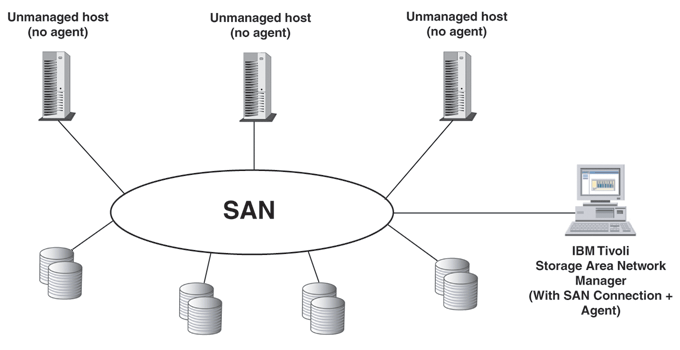What Is Storage Area Network
Storage Area Network (SAN) refers to a network of data storage devices. It is a specialized, high-speed network that enables you to access to consolidated, block-level data storage. The storage area network consists of interconnected hosts, switches, as well as storage devices.
A SAN contains 2 tiers (storage plumbing tier and the software tier). The storage plumbing tier can offer connectivity between nodes in the network and transports device-oriented commands and status.

-image from publib.boulder.ibm.com
One more thing should be noted is that ensuring at least one storage node is connected to this network. As for the software tier, it can provide value-added services based on the first tier.
There are 3 available storage options for users: direct-attached storage (DAS), network-attached storage (NAS), and storage area networks (SAN) discussed in this post. SAN has a lot of advantages. You can preview them in here.
- High faulty tolerance
- Concentrated storage management
- Without scalability imposed by SCSI bus-based implementations
- Without bandwidth bottlenecks related to LAN-based server storage
- High availability
- Faster backups
- Commonly used file systems
- Quick data migration
- High data security level
- Great storage utilization
- Etc.
Main Storage Area Network Types
The storage area network has several types. In this section, four frequently used SAN protocols (Fibre Chanel Protocol, Internet Small Computer System Interface, Fibre Channel over Ethernet, and Non-Volatile Memory Express over Fibre Channel) will be talked about.
- Fibre Channel Protocol (FCP): It is the most commonly used SAN or block protocol, occupying 70% to 80% SAN consumption market. FCP utilizes Fibre Channel transport protocols with the embedded SCSI commands.
- Internet Small Computer System Interface (ISCSI): It is the second widely used SAN or block protocol with a market share of 10% to 15%. ISCSI seals the SCSI commands within an Ethernet frame. It transports signals via the IP Ethernet network.
- Fibre Channel over Ethernet (FCoE): It has a low market share (less than 5%). Like ISCSI, it places an FC frame inside an Ethernet datagram and transport signals by using IP ethernet network.
- Non-Volatile Memory Express over Fibre Channel (FC-NVMe): NVMe, an interface protocol, is used to access flash storage through PCI Express (PCIe) bus. It supports numerous parallel queues and each of them is capable of supporting tens of thousands of concurrent commands. That is different from conventional all-flash architectures supporting only one serial command queue.
Top recommendation: How to Choose Right Storage Space for Your Server or NAS
Common Uses of Storage Area Network
What storage area network can be for? Actually, as san definition implies, it is mainly used to access storage devices like disk arrays and tape libraries from servers. In this way, devices will show to the operating system as direct-attached storage.
This simplified presentation of storage to the host is finished by using various virtualization methods. The storage area network is often used to improve application availability and boost application performance.
The SAN is also applied in Business Continuity because of its advanced features especially in supporting business-critical, performance-sensitive applications. To be specific, it is usually used in the following cases.
Oracle databases: They require the highest performance and availability.
Microsoft SQL server databases: They store the most valuable data of a firm and has high standards for performance and availability that are similar to Oracle databases.
Large virtualization deployments that utilizes VMware, KVM, or Microsoft Hyper-V: As they are associate with thousands of virtual machines running with various operating systems and programs, infrastructure reliability is very important. Once it works wrong, it can cause multiple application outages.
Large virus desktop infrastructures (VDIs): They provide virtual desktops (sometimes the number can be up to tens of thousands) to the member of an organization. And the organizations are able to take the data protection and data security under control by centralizing the virtual desktops.
SAP or other large ERP or CRM environments: SANs are suitable for enterprise resource scheduling and customer resource management workloads.
The Bottom Line
What is storage area network? After reading the post, you may have an overall understanding of san storage. Some extra information such as the advantages, main types and common uses in life is also introduced.
User Comments :